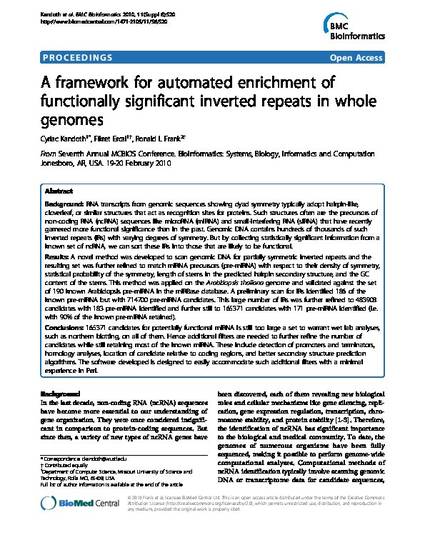
Background: RNA transcripts from genomic sequences showing dyad symmetry typically adopt hairpin-like, cloverleaf, or similar structures that act as recognition sites for proteins. Such structures often are the precursors of non-coding RNA (ncRNA) sequences like microRNA (miRNA) and small-interfering RNA (siRNA) that have recently garnered more functional significance than in the past. Genomic DNA contains hundreds of thousands of such inverted repeats (IRs) with varying degrees of symmetry. But by collecting statistically significant information from a known set of ncRNA, we can sort these IRs into those that are likely to be functional.
Results: A novel method was developed to scan genomic DNA for partially symmetric inverted repeats and the resulting set was further refined to match miRNA precursors (pre-miRNA) with respect to their density of symmetry, statistical probability of the symmetry, length of stems in the predicted hairpin secondary structure, and the GC content of the stems. This method was applied on the Arabidopsis thaliana genome and validated against the set of 190 known Arabidopsis pre-miRNA in the miRBase database. A preliminary scan for IRs identified 186 of the known pre-miRNA but with 714700 pre-miRNA candidates. This large number of IRs was further refined to 483908 candidates with 183 pre-miRNA identified and further still to 165371 candidates with 171 pre-miRNA identified (i.e. with 90% of the known pre-miRNA retained).
Conclusions: 165371 candidates for potentially functional miRNA is still too large a set to warrant wet lab analyses, such as northern blotting, on all of them. Hence additional filters are needed to further refine the number of candidates while still retaining most of the known miRNA. These include detection of promoters and terminators, homology analyses, location of candidate relative to coding regions, and better secondary structure prediction algorithms. The software developed is designed to easily accommodate such additional filters with a minimal experience in Perl.
- Additional Filters,
- Arabidopsis Thaliana,
- Non-Coding RNA (NcRNA),
- Northern Blotting,
- Secondary Structure Prediction,
- Secondary Structures,
- Small Interfering Rna (SiRNA),
- Statistical Probability, Algorithms,
- Computer Software,
- Genes, RNA, Arabidopsis,
- Arabidopsis Thaliana, MicroRNA,
- Small Interfering RNA, Arabidopsis,
- Article,
- Chemistry,
- DNA Base Composition,
- Genetics,
- Genome,
- Genomics,
- Inverted Repeat,
- Methodology,
- Nucleotide Sequence, Arabidopsis,
- Base Composition,
- Base Sequence,
- Genome,
- Genomics,
- Inverted Repeat Sequences,
- MicroRNAs,
- RNA, Small Interfering
Available at: http://works.bepress.com/ronald-frank/12/
